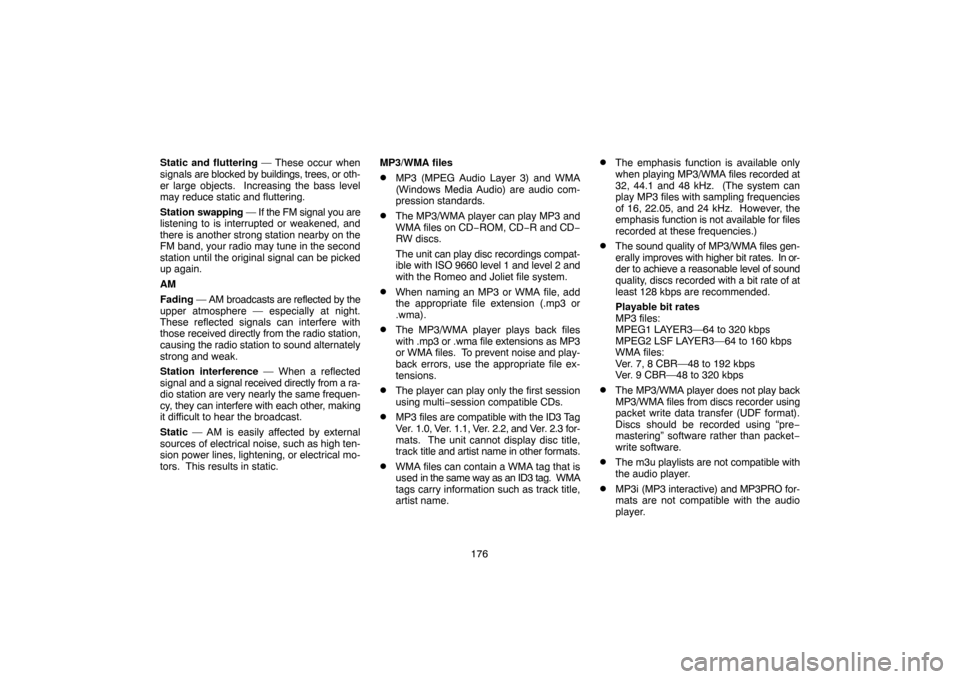Page 111 of 207

100
�Microphone
You can use the microphone above when
talking on the phone.The other party’s voice outputs from the driv-
er’s speaker. When the received calls or re-
ceived voice outputs, the audio from the audio
system or voice guidance from the navigation
system will be muted.
INFORMATION
�Talk alternately with the other party on
the phone. If you talk at the same time,
the voice may not reach each other. (It
is not a malfunction.)
�Keep the volume of receiving voice
down. Otherwise, echo is coming up.
When you talk on the phone, speak
clearly towards the microphone.
�In the following situations, your voice
may not reach the other party.
�Driving on unpaved road. (Making
a traffic noise.)
�Driving at the high speed.
�The window is open.
�Turning the air�conditioning vents
towards the microphone.
�The sound of the air�conditioning
fan is loud.
1Indicates the condition of Bluetooth
connection.
“Blue” indicates an excellent connection to
Bluetooth.
“Yellow” indicates a bad connection to Blue-
tooth, resulting in possible deterioration of
voice quality.
: No connection to Bluetooth.
2Indicates the amount of battery
charge left.
Empty Full
It is not displayed while the Bluetooth is con-
necting or the phone book data is being trans-
ferred.
The amount left does not always correspond
with the one of your cellular phone. This sys-
tem doesn’t have a charging function.
Page 187 of 207

176 Static and fluttering — These occur when
signals are blocked by buildings, trees, or oth-
er large objects. Increasing the bass level
may reduce static and fluttering.
Station swapping — If the FM signal you are
listening to is interrupted or weakened, and
there is another strong station nearby on the
FM band, your radio may tune in the second
station until the original signal can be picked
up again.
AM
Fading — AM broadcasts are reflected by the
upper atmosphere — especially at night.
These reflected signals can interfere with
those received directly from the radio station,
causing the radio station to sound alternately
strong and weak.
Station interference — When a reflected
signal and a signal received directly from a ra-
dio station are very nearly the same frequen-
cy, they can interfere with each other, making
it difficult to hear the broadcast.
Static — AM is easily affected by external
sources of electrical noise, such as high ten-
sion power lines, lightening, or electrical mo-
tors. This results in static.MP3/WMA files
�MP3 (MPEG Audio Layer 3) and WMA
(Windows Media Audio) are audio com-
pression standards.
�The MP3/WMA player can play MP3 and
WMA files on CD−ROM, CD−R and CD−
RW discs.
The unit can play disc recordings compat-
ible with ISO 9660 level 1 and level 2 and
with the Romeo and Joliet file system.
�When naming an MP3 or WMA file, add
the appropriate file extension (.mp3 or
.wma).
�The MP3/WMA player plays back files
with .mp3 or .wma file extensions as MP3
or WMA files. To prevent noise and play-
back errors, use the appropriate file ex-
tensions.
�The player can play only the first session
using multi−session compatible CDs.
�MP3 files are compatible with the ID3 Tag
Ver. 1.0, Ver. 1.1, Ver. 2.2, and Ver. 2.3 for-
mats. The unit cannot display disc title,
track title and artist name in other formats.
�WMA files can contain a WMA tag that is
used in the same way as an ID3 tag. WMA
tags carry information such as track title,
artist name.
�The emphasis function is available only
when playing MP3/WMA files recorded at
32, 44.1 and 48 kHz. (The system can
play MP3 files with sampling frequencies
of 16, 22.05, and 24 kHz. However, the
emphasis function is not available for files
recorded at these frequencies.)
�The sound quality of MP3/WMA files gen-
erally improves with higher bit rates. In or-
der to achieve a reasonable level of sound
quality, discs recorded with a bit rate of at
least 128 kbps are recommended.
Playable bit rates
MP3 files:
MPEG1 LAYER3—64 to 320 kbps
MPEG2 LSF LAYER3—64 to 160 kbps
WMA files:
Ver. 7, 8 CBR—48 to 192 kbps
Ver. 9 CBR—48 to 320 kbps
�The MP3/WMA player does not play back
MP3/WMA files from discs recorder using
packet write data transfer (UDF format).
Discs should be recorded using “pre−
mastering” software rather than packet−
write software.
�The m3u playlists are not compatible with
the audio player.
�MP3i (MP3 interactive) and MP3PRO for-
mats are not compatible with the audio
player.
Page 192 of 207
181 m3u—
Playlists created using “WINAMP” software
have a playlist file extension (.m3u).
MP3—
MP3 is an audio compression standard deter-
mined by a working group (MPEG) of the ISO
(International Standard Organization). MP3
compresses audio data to about 1/10 the size
of that on conventional discs.
WMA—
WMA (Windows Media Audio) is an audio
compression format developed by Microsoft.
It compresses files into a size smaller than
that of MP3 files. The decoding formats for
WMA files are Ver. 7, 8, and 9.
Page 195 of 207

184
Limitations of the
navigation system
This navigation system calculates the cur-
rent vehicle position using satellite sig-
nals, various vehicle signals, map data,
etc. However, the accurate position may
not be shown depending on the satellite
condition, road configuration, vehicle
condition or other circumstances.
The Global Positioning System (GPS) devel-
oped and operated by the U.S. Department of
Defense provides an accurate current vehicle
position using 3 to 4 satellites. The GPS sys-
tem has a certain level of inaccuracy. While
the navigation system will compensate for
this most of the time, occasional positioning
errors of up to 300 feet (100 m) can and
should be expected. Generally, position er-
rors will be corrected within a few seconds.
When your vehicle is receiving signals from
the satellites, the “GPS” mark appears at the
top left of the screen.
The GPS signal may be physically ob-
structed, leading to inaccurate vehicle posi-
tion on the map display. Tunnels, tall build-
ings, trucks, or even the placement of objects
on the instrument panel may obstruct the
GPS signals.
The GPS satellites may not send signals due
to repairs or improvements being made to
them.
Even when the navigation system is receiving
clear GPS signals, the vehicle position may
not be shown accurately or inappropriate
route guidance may occur in some cases.
NOTICE
The installation of window tinting may
obstruct the GPS signals. Most window
tinting contains some metallic content
that will interfere with GPS signal recep-
tion. We advise against the use of win-
dow tinting on vehicles equipped with
navigation systems.